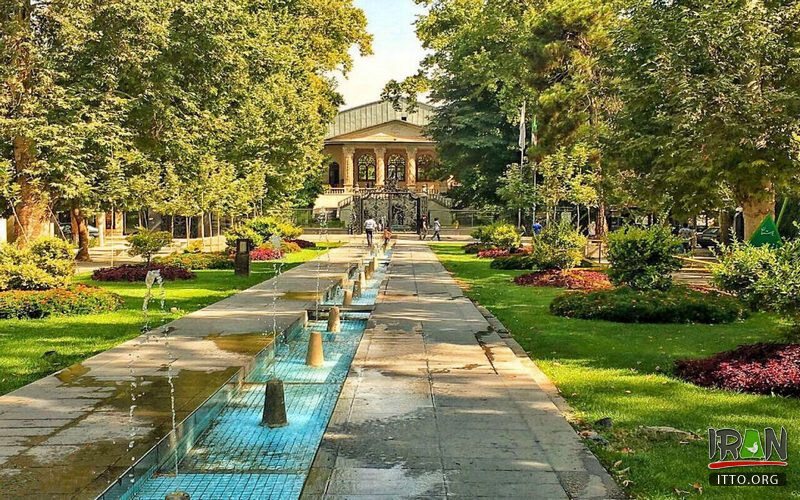Cinema Museum of Iran at the Ferdows Garden (Bagh Ferdows) Housed in a beautiful Qajar-era mansion surrounded by a pleasant garden, this interesting museum has well-displayed and explained (in English) exhibits of equipment, photos and posters from Iran’s century-old movie industry. The highlight is a working cinema, Iran's first, with ornate moulded plaster ceilings.
New and classic Iranian films are screened here at 1pm, 3pm, 5pm, 7pm and 9pm daily; get a Farsi-speaker to call to see what’s on. A shop also sells hard-to-find Iranian films on DVD. The museum is a 10-minute walk down Valiasr Ave. from Tajrish Sq; look for the broad street with a garden down the middle leading to the museum.

After the 1979 Revolution, until 2002, Ferdows Garden served as a training center for filmmaking. Since 2002, it houses the Cinema Museum.
The establishment of the Cinema Museum of Iran was the fulfillment of a dream; an accomplishment that delighted the advocates of Iranian culture with the promise that the efforts of the founders and enthusiasts of this artistic industry will be recorded and safeguarded as a guiding light for the future generations, as well as a source of pride and honor for those who have watched the reflection of their lifetime achievements on the silver screen. By the foresight and aspiration of the managers of the Cultural Spaces Development Company (affiliated to Tehran Municipality), the Cinema Museum of Iran was launched in September 1994, aiming to collect, safeguard, record and provide a proper presentation of the Iranian cinematic heritage.
With the faith and support of Messers Abbas Kiarostami and Ezatollah Entezami, and the diligent efforts of Messrs Jamal Omid, Amir Esbati, Behzad Rahimian and Azizollah Sa’ati, the efforts of the museum founders eventually paid off in May 1998. The original building of the museum was opened in Pirnia alley (Lalehzar Street) in a ceremony attending cinema personalities and supporters, as well as the IRI vice-president Mr. Habibi.
Exactly four years later, the museum was moved to its current location and reopened in September 2002 in the presence of His Excellency President Mohammad Khatami. It has been proceeding with its activities in the current format ever since, and receives a large number of visitors from cinema enthusiasts to researchers everyday.

Ferdows Garden (Bagh e Ferdows) is a historical complex located in the district of Tajrish in Shemiran (northern Tehran), Iran.
Ferdows Garden (Bagh e Ferdows) is a historical complex located in the district of Tajrish in Shemiran (northern Tehran), Iran. The complex dates back to the reign of the Qajar dynasty, and includes a mansion which houses the Cinema Museum of Iran since 2009.
The origin of complex dates back to the reign of Mohammad Shah (1808–1848) of the Qajar dynasty, who ordered the construction of a mansion named Mohammadie in Tajrish. He died in September 1848, and the unfinished structure was subsequently disused.
Later on, Hossein Ali Khan (Moayyer ol Mamalek), a courtier close to Mohammad Shah, followed up the construction of a two-floor Qajar-style mansion within the same area. During the reign of Naser ed Din Shah (1848–1896), the ownership of the enclosure was transferred to Dust-Ali Khan (Nezam od Dowle), the son of Hossein Ali Khan. He refurbished the complex and renamed it Ferdows. Afterwards, Dust-Mohammad Khan, the son of Dust-Ali Khan and the son-in-law of Naser ed Din Shah, built a new mansion to the south of the enclosure. He used the workmanship of architects from Isfahan and Yazd, and named it Rashk e Behesht, meaning "the Envy of Heaven".
The complex changed several hands, and the older mansion was eventually destroyed. The remaining structure was then bought by Mohammad-Vali Khan Tonekaboni, who was the leader of the Constitutionalist Revolutionary Forces from Iran's northern regions of Gilan and Mazandaran. He added new pools and fountains to the complex, and regenerated the aqueduct that, in earlier years, had fed the garden with fresh water. The current gate of the garden also dates from this time. The complex was leased to various ministries over years. In 1937, the Ministry of Education housed the primary and secondary school of Shapur in this compound. After the 1979 Revolution, until 2002, Ferdows Garden served as a training center for filmmaking. Since 2002, it houses the Cinema Museum.

